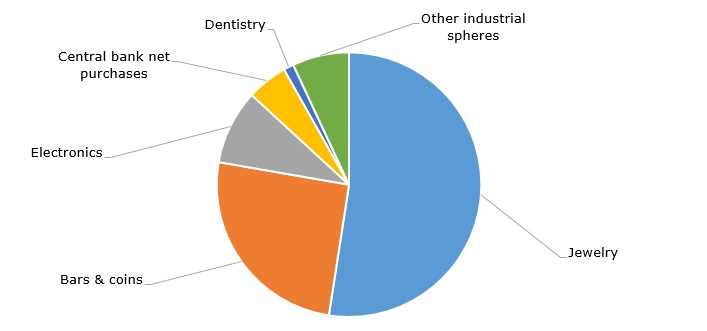Gold Market: Countries Boasting the Largest Mine Reserves and Production
14 Sep 2018 • by Natalie Aster

LONDON – Gold is one of the most valuable and at the same time rarest elements existing in nature. Gold boasts a range of unique properties: it has high softness, conducts heat and electricity well, doesn’t corrode and discolor when exposed to water or air, and isn’t affected by concentrated acids and bases.
GOLD DEMAND
The world’s demand for gold has fluctuated considerably over the recent decade. The highest demand was reported in 2011 – more than 4.73 thousand tons. During 2012 – 2015, the global gold demand demonstrated a steady decline. It improved in 2016 registering a YoY growth of about 97 metric tons. However, the world’s gold demand fell to around 4.07 thousand metric tons in 2017.
World’s demand for gold during 2007 – 2017 (in thousand metric tons) .jpg)
The jewelry industry is the dominant contributor to the world’s total demand for gold. This sector holds a share of over 50% of the global gold demand volume. A substantial amount of gold is required for bars and coins – slightly over 25% of the overall demand, as gold is viewed as one of the most popular investment options. The electronics industry accounts for above 9% of the world’s total demand for gold.
Structure of global gold demand by end-use sphere, 2017 
GOLD MINE RESERVES
Last year, the world’s overall gold reserves were estimated at 54 thousand tonnes. 5 countries boasting the largest mine reserves of gold together grabs a share of almost 50% of the world’s total gold mine reserves.
Australia possesses the richest deposits of gold across the globe. According to the estimates of the past year, Australia has some 9,800 metric tons of gold reserves in the local mines.
The second spot on the global list of the countries with the biggest gold reserves is held by South Africa. The country’s deposits were estimated at nearly 6,000 metric tons in the year 2017.
The third largest gold reserves worldwide are in Russia – appr. 5,500 metric tons in 2017.
The US and Indonesia are ranked the fourth and the fifth in the world in terms of gold mine reserves volume, respectively. The US has about 3,000 metric tons in the local gold mines, whilst Indonesia boasts reserves of close to 2,500 metric tons.
Top 10 countries in terms of gold mine reserves, 2017 (in thousand metric tons)
.jpg)
Other countries that have sufficient gold mine reserves include Mexico, Papua New Guinea, Ghana, Kazakhstan, and Chile.
GOLD MINE PRODUCTION
Nowadays, gold mining is a worldwide business with operations on all continents, except Antarctica. Meantime, four decades or so ago, gold mining operations were concentrated in South Africa. Today, gold is extracted from mines of a great variety of types and scales.
Presently, Asia supplies around 23% of the world’s total volume of newly-mined gold, whilst the African region accounts for appr. 19%. Around 17% of the global gold mine output comes from Central and South America. Meantime, North America contributes nearly 16% of the world’s total figure, and the CIS region grabs a share of 14% of the global volume of gold mine output.
Although the overall level of gold mine production has grown remarkably during the last decade, substantial new discoveries of gold deposits are increasingly rare and, therefore, production levels are considerably constrained. At present, mine production contributes a bulk share of about 75% to the world’s total gold supply volume. However, the mounting demand for gold across the globe requires much more gold than is newly extracted from mines, and the shortfall is filled from recycling.
The world’s mine production of gold has been steadily growing after the economic crisis of 2008. As of 2008, the volume of the global mine production of gold totaled around 2.28 thousand metric tons. During 2014 – 2017, the gold mine production witnessed sluggish growth. In 2017, it added only 40 metric tons and climbed to 3,15 metric tons.
World’s gold mine production between 2005 and 2017 (in thousand metric tons)
.jpg)
China holds the dominant position amid the global gold-producing countries, holding a chunk of about 13.9% of the world’s total gold mine production volume. The country’s mine production of gold grew from 320 metric tons in the year 2009 to reach some 440 metric tons in the past year. However, in 2017 China’s gold mine production registered a moderate YoY decline, in 2015 the volume of the domestic gold mine production totaled some 456 metric tons. Despite the leading position on the global arena, large-scale gold production in China is minimal with only 1 mine exceeding 8.5 metric tons of gold – the Zijinshan gold-copper mine located in Fujan Province.
Australia is the second leading mine producer of gold across the world capturing a share of about 9.5% of the world’s total gold mine production volume. In 2017, the Australian mine production of gold registered a YoY gain of 10 metric tons and climbed to 300 metric tons.
The third leading gold-producing country is Russia, it grabs a share of nearly 8% of the global gold mine output. Last year, the gold mine production in Russia increased by 2 metric tons YoY and reached 255 metric tons.
Top countries in terms of gold production, 2016 – 2017 (in metric tons)
.jpg)
In 2017, the US closely followed Russia and took the fourth spot on the list of the global gold mine producers with the output volume of some 245 metric tons.
The fifth country in the top 5 gold mine producers ranking is Canada. The Canadian gold mine output grew by 17 metric tons YoY and totaled 180 metric tons in 2017.
GOLD MARKET OUTLOOK
The world’s gold market has positive future prospects with substantial growth potential for gold mining. This market is poised to see stable, healthy growth in the years ahead spurred by the rising demand from the key end uses, an upturn in the emerging regions, increasing government investments in gold, and also a revival of closed mines worldwide, amid other favourable factors. However, growth in the gold market may be hampered by a number of factors, for instance, lack of skilled labor force, increasing trade protectionism, depleting gold reserves, and fatal mining accidents.
As for applications, the jewelry sector is forecast to stay in the lead in terms of gold consumption, whilst the highest demand growth is predicted in the electronics industry.
Regionally, APAC is anticipated to stay at the forefront of the world’s gold market, whilst the fastest growth in the next few years will be registered in the North American region.
© MarketPublishers.com, 2018
Analytics & News
